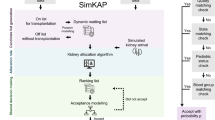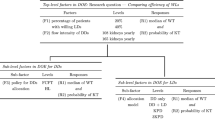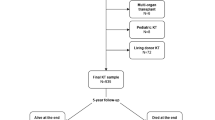Abstract
The current kidney allocation system in the United States fails to match donors and recipients well. In an effort to improve the allocation system, the United Network of Organ Sharing (UNOS) defined factors that should determine a new allocation policy, and particularly patients’ potential remaining lifetime without a transplant (pre-transplant survival rates). Estimating pre-transplant survival rates is challenging because the data available on candidates and organ recipients is already “contaminated” by the current allocation policy. In particular, the selection of patients who are offered (and decide to accept) a kidney is not random. We therefore expect differences in mortality-related characteristics of organ recipients and of candidates who have not received transplant. Such differences introduce bias into survival models.
Existing approaches for tackling this selection bias either ignore the difference between candidates and recipients or assume that selection to transplant is based solely on patients’ pre-transplant information, irrespective of the potential allocation outcome. We argue that in practice the allocation is dependent on the anticipated allocation outcome, which is a major factor in selection to transplant. Moreover, we show that ignoring the anticipated outcome increases model bias rather than decreases it. In this paper, we propose a novel simulator-based approach (SimBa) that adjusts for the selection bias by taking into account both pre-transplant and anticipated outcome information using simulation. We then fit survival models to kidney transplant waitlist data and compare the different adjustment methods. We find that SimBa not only fits the data best, but also captures a key aspect of the current allocation policy, namely, that the probability of kidney allocation increases in the expected pre-transplant life years.













Similar content being viewed by others
Notes
Health condition in KPSAM is modeled through (1) medical updates recorded during major status changes (given to the simulator as an input), and (2) time-dependent variables, such as age, dialysis time, etc. that the simulator automatically keeps updated over time. The simulation also incorporates health updates in a more realistic way compared to any static model (such as the logistic regression): updated information is introduced into the model only when it becomes available (i.e., when the change occurs), and only if it occurs before the event of transplant or death. In contrast, static models include status update information in a static fashion, as if it is available upon patient arrival, and irrespective of the outcome.
Simultaneous transplantation of a kidney and pancreas is performed for those who have kidney failure as a complication of insulin-dependent diabetes mellitus (also called Type I diabetes).
The data reported here have been supplied by the United Network for Organ Sharing as the contractor for the Organ Procurement and Transplantation Network. The interpretation and reporting of these data are the responsibility of the author(s) and in no way should be seen as an official policy of or interpretation by the OPTN or the U.S. Government.
Under the assumption of Poisson arrival times, as evidenced from the data.
We examined predictive accuracy for the deceased group based on separate training and holdout samples. While all three survival models generated mostly near-zero prediction errors, SimBa was much better at predicting PTLY values of deceased candidates who joined the waitlist late in the study and died early. This result emphasizes the importance of including the arrival time (rather than only the PTLY) in the model.
References
Bavaria, J., Appoo, J., Makaroun, M., Verter, J., Yu, Z., Mitchell, R., & Gore, T. (2007). Endovascular stent grafting versus open surgical repair of descending thoracic aortic aneurysms in low-risk patients: a multicenter comparative trial. The Journal of Thoracic and Cardiovascular Surgery, 133(2), 369–377.
Binder, D. (1992). Fitting Cox’s proportional hazards models from survey data. Biometrika, 79(1), 139–147.
Cho, K., Himmelfarb, J., Paganini, E., Ikizler, T., Soroko, S., Mehta, R., & Chertow, G. (2006). Survival by dialysis modality in critically ill patients with acute kidney injury. Journal of the American Society of Nephrology, 17(11), 3132.
D’Agostino, R. J. (1998). Tutorial in biostatistics: propensity score methods for bias reduction in the comparison of a treatment to a non randomized control group. Statistics in Medicine, 17, 2265–2281.
D’Agostino, R. B. J. (2007). Propensity scores in cardiovascular research. Circulation, 115(17), 23–40.
Demissie, S., LaValley, M., Horton, N., Glynn, R., & Cupples, L. (2003). Bias due to missing exposure data using complete-case analysis in the proportional hazards regression model. Statistics in Medicine, 22(4), 545–557.
Efron, B., & Tibshirani, R. (1993). An introduction to the bootstrap (Vol. 57). London: Chapman & Hall/CRC.
Engoren, M., Habib, R., Zacharias, A., Schwann, T., Riordan, C., & Durham, S. (2002). Effect of blood transfusion on long-term survival after cardiac operation. The Annals of Thoracic Surgery, 74(4), 1180–1186.
Field, C., & Smith, B. (1994). Robust estimation: a weighted maximum likelihood approach. International Statistical Review, 62(3), 405–424.
Garonzik-Wang, J., James, N., Weatherspoon, K., Deshpande, N., Berger, J., Hall, E., Montgomery, R., & Segev, D. (2012). The aggressive phenotype: center-level patterns in the utilization of suboptimal kidneys. American Journal of Transplantation.
Henry, G. T. (1990). Practical sampling. Thousand Oaks: Sage.
Kenett, R. S., & Shmueli, G. (2013, forthcoming). On information quality, with discussion. Journal of the Royal Statistical Society, Series A.
Kleinbaum, D. G., & Klein, M. (1995). Survival analysis: a self-learning text. Berlin: Springer.
KPSAM (2009). Kidney-pancreas simulated allocation model. Arbor research collaborative for health, scientific registry of transplant recipients (4th ed.).
Lambert, P., Collett, D., Kimber, A., & Johnson, R. (2004). Parametric accelerated failure time models with random effects and an application to kidney transplant survival. Statistics in Medicine, 23(20), 3177–3192.
Lee, B., Lessler, J., & Stuart, E. (2010). Improving propensity score weighting using machine learning. Statistics in Medicine, 29(3), 337–346.
Lin, D. (2000). On fitting Cox’s proportional hazards models to survey data. Biometrika, 87(1), 37–47.
Mathur, A., Ashby, V., Sands, R., & Wolfe, R. (2010). Geographic variation in end-stage renal disease incidence and access to deceased donor kidney transplantation. American Journal of Transplantation, 10(4p2), 1069–1080.
Mauger, E., Wolfe, R., & Port, F. (1995). Transient effects in the Cox proportional hazards regression model. Statistics in Medicine, 14(14), 1553–1565.
OPTN/UNOS (2008). Kidney allocation concepts, request for information. The Kidney Transplantation Comittee.
Pan, Q., & Schaubel, D. (2008). Proportional hazards models based on biased samples and estimated selection probabilities. Canadian Journal of Statistics, 36(1), 111–127.
Pan, Q., & Schaubel, D. (2009). Evaluating bias correction in weighted proportional hazards regression. Lifetime Data Analysis, 15(1), 120–146.
Polkinghorne, K., McDonald, S., Atkins, R., & Kerr, P. (2004). Vascular access and all-cause mortality: a propensity score analysis. Journal of the American Society of Nephrology, 15(2), 477–486.
Rosenbaum, P. R., & Rubin, D. B. (1983). The central role of the propensity score in observational studies for causal effects. Biometrika, 70(1), 41–55.
Rosenbaum, P. R., & Rubin, D. B. (1984). Reducing bias in observational studies using subclassification on the propensity score. Journal of the American Statistical Association, 79(387), 516–524.
Schaubel, D., Guidinger, M., Biggins, S., Kalbfleisch, J., Pomfret, E., Sharma, P., & Merion, R. (2009). Survival benefit-based deceased-donor liver allocation. American Journal of Transplantation, 9(4p2), 970–981.
Sela, R., & Simonoff, J. (2011). Re-em trees: a data mining approach for longitudinal and clustered data. Machine Learning, 1–39.
Shyur, H., Elsayed, E., & Luxhøj, J. (1999). A general hazard regression model for accelerated life testing. Annals of Operations Research, 91, 263–280. Special issue on reliability and maintenance in production control.
SRTR (2007a). Methods for discounting median lifetimes (Working paper).
SRTR (2007b). Predicting the life years from transplant (LYFT): choosing a metric (Working paper).
Stürmer, T., Schneeweiss, S., Brookhart, M., Rothman, K., Avorn, J., & Glynn, R. (2005). Analytic strategies to adjust confounding using exposure propensity scores and disease risk scores: nonsteroidal antiinflammatory drugs and short-term mortality in the elderly. American Journal of Epidemiology, 161(9), 891–898.
UNOS UNoOS (2011). Allocation of deceased kidneys (3.5).
Votruba, M. (2001). Efficiency-equity tradeoffs in the allocation of cadaveric kidneys (Working Paper). Princeton University.
Wolfe, R. (2007). Avoiding statistical bias in predicting the life years from transplant (LYFT) (Working Paper. SRTR Working Paper).
Wolfe, R., McCullougha, K., Schaubelb, D., Kalbfleisch, J., Murrayb, S., Stegallc, M., & Leichtmanb, A. (2008). Calculating life years from transplant (LYFT): methods for kidney and kidney-pancreas candidates. American Journal of Transplantation, 2008(8 part 2), 997–1011.
Yahav, I., & Shmueli, G. (2010). Predicting potential survival rates of kidney transplant candidates from databases with existing allocation policies. In D. Sundaramoorthi, M. Lavieri, & H. Zhao (Eds.), Proceedings of the 5th INFORMS workshop on data mining and health informatics (DM-HI 2010), Austin, TX.
Zenios, S. (2004). Models for kidney allocation. In Operations research and health care: a handbook of methods and applications (pp. 537–554).
Author information
Authors and Affiliations
Corresponding author
Additional information
This work was supported in part by Health Resources and Services Administration contract HHS/HRSA SRTR. The content is the responsibility of the authors alone and does not necessarily reflect the views or policies of the Department of Health and Human Services, nor does mention of trade names, commercial products, or organizations imply endorsement by the U.S. Government.
Appendices
Appendix A: Description of variables in U.S. kidney waitlist dataset
Below is a list of variables used throughout the paper. We list their abbreviation and description.
- ABO type AB (ABO_AB):
-
Patient’s blood group is AB
- ABO type B (ABO_B):
-
Patient’s blood group is B
- ABO type O (ABO_O):
-
Patient’s blood group is O
- Age (AGE):
-
Patient’s age upon arrival
- African American (AFRICAN):
-
Patient’s race is African American
- Albumin (ALBUMIN):
-
Patient albumin level. Low albumin levels reflect possibility of diseases in which the kidneys cannot prevent albumin from leaking from the blood into the urine and being lost
- Body Mass Index (BMI):
-
Patient’s Body Mass Index (ratio of weight to square root of the hight). BMI provided a measure of a patient’s overweight (BMI > 25) or underweight (BMI < 18.5)
- Diabetes (DIAB):
-
Indicates whether a patient is diabetic
- Diagnosis unknown (NotSPECIFIED):
-
Indicates whether a patient has no diagnosis
- Dialysis (DIAL):
-
Indicates whether a patient needs dialysis
- Functional status: minor disability (MINOR_DIS):
-
Patient can function with no assistance
- Functional status: some disability (SOME_DIS):
-
Patient can function with little assistance
- Hospitalization History (HOSPITALIZATION):
-
Number of previous hospitalizations
- Hypertension (HYPERTENSION):
-
Indicates whether a patient was diagnosed with malignant hypertension (a complication of hypertension characterized by very elevated blood pressure)
- Human Leukocyte Antigen (HLA):
-
Mean patient’s antigen match with donors pool (ranges between [0,6])
- Male (MALE):
-
Patient’s gender is male
- No Antigens (ABDR):
-
Indicates weather the patients has no antigens
- Number of A antigens (A):
-
Number of a patient’s A antigens
- Number of B antigens (B):
-
Number of a patient’s B antigens
- Number of DR antigens (DR):
-
Number of a patient’s DR antigens
- Panel Reactive Body (PRA):
-
Patient’s Panel Reactive Antibody (PRA) level (measure for sensitization level)
- Polycystic kidneys (POLYCYSTIC):
-
Indicates weather a patient was diagnosed with polycystic kidney syndrome (a genetic disorder that results in massive enlargement of the kidneys)
- Previous transplant (PrevTRANS):
-
Indicates whether a patient had previous transplants
- Simultaneous kidney-pancreas (KP):
-
Indicates whether a patient is waiting for simultaneous pancreas-kidney transplant
- Time on dialysis (DT):
-
Dialysis time in years upon arrival
Appendix B: Graphical comparison between the AFT models
Rights and permissions
About this article
Cite this article
Yahav, I., Shmueli, G. Outcomes matter: estimating pre-transplant survival rates of kidney-transplant patients using simulator-based propensity scores. Ann Oper Res 216, 101–128 (2014). https://doi.org/10.1007/s10479-013-1359-7
Published:
Issue Date:
DOI: https://doi.org/10.1007/s10479-013-1359-7





